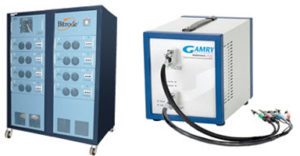The 26th Annual Fall EIS Short Course:
Electrochemical Impedance Spectroscopy:
Theory – Applications – Laboratory Instruction
Dates: November 10-14, 2014
Where: Houston, Tx
 Course Overview
Course Overview
Impedance spectroscopy is an extremely powerful non-destructive investigative technique that can obtain essential information about interfacial and bulk material parameters through the use of low energy, time varying electrical excitation. When applied to an electrochemical system, electrochemical impedance spectroscopy (EIS) can provide information on reaction parameters, corrosion rates, oxide characteristics and integrity, surface porosity, coating integrity, mass transport, and many other electrode/interface characteristics. EIS is possibly one of the most powerful methods available in electrochemistry today and is utilized in research and development in essentially every technical sector, e.g., transportation and infrastructure, batteries and fuel cells, medicine, among many others. However, effective utilization of this method has been hindered by the lack of a comprehensive and cohesive explanation of the theory, measurement, and analysis techniques. This course on EIS has been developed to fill this void.
This short course, now in its 26th year, was first taught in 1988 in Charlottesville, Virginia. It has recently had the tremendous fortune of moving to the vibrant and technologically rich city of Houston, Texas. Please read more about our course on this website, or contact us either by e-mail or telephone.
Course Objective […]









 Electrochemical Impedance Spectroscopy can identify problems that limit a fuel cell’s efficiency, by helping to optimize a cell, it can determine anodic and cathodic process mechanisms. EIS is particularly good for measuring the equivalent series resistance of fuel cells, a major source of power loss in a low impedance device. Because of the modeling capability of EIS, you can also extract information on kinetics and mass transport in the fuel cell, both of which are crucial factors to fuel cell performance. EIS is useful in both research and QC applications. EIS of fuel cells runs into some of the same low impedance device and setup limitations that also show up in batteries and supercapacitors.
Electrochemical Impedance Spectroscopy can identify problems that limit a fuel cell’s efficiency, by helping to optimize a cell, it can determine anodic and cathodic process mechanisms. EIS is particularly good for measuring the equivalent series resistance of fuel cells, a major source of power loss in a low impedance device. Because of the modeling capability of EIS, you can also extract information on kinetics and mass transport in the fuel cell, both of which are crucial factors to fuel cell performance. EIS is useful in both research and QC applications. EIS of fuel cells runs into some of the same low impedance device and setup limitations that also show up in batteries and supercapacitors.

 Course Overview
Course Overview

